

Thesis Statements Worksheets
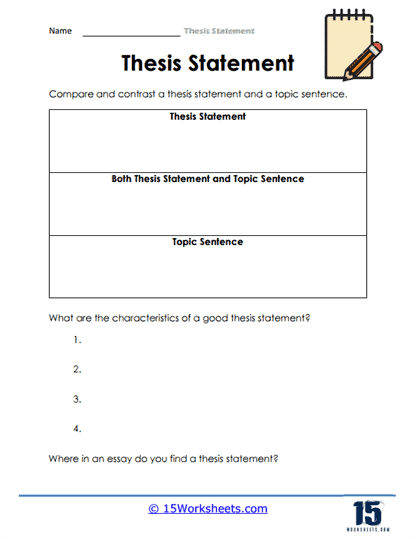
Compare And Contrast
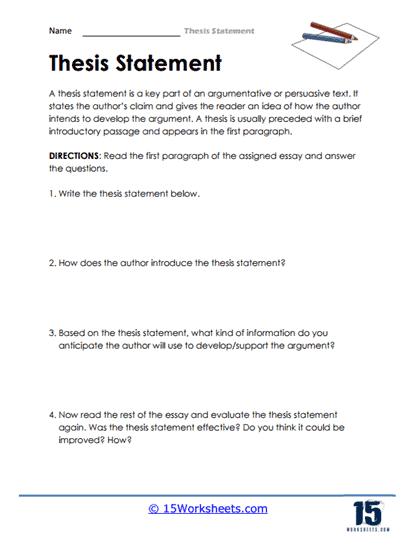
The First Paragraph
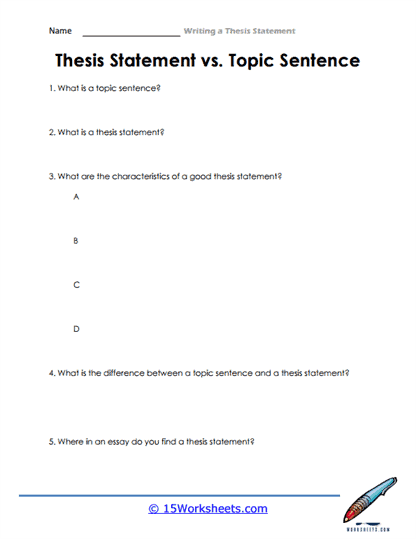
Statement Vs. Sentence
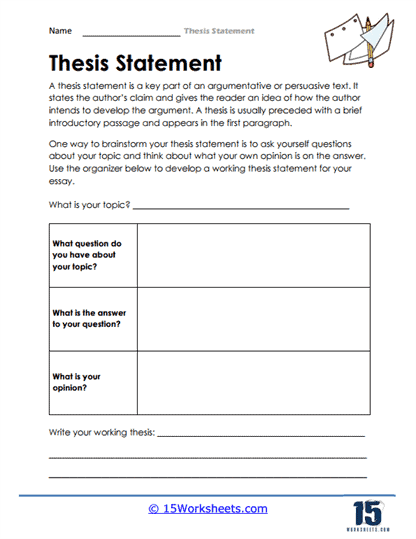
Brainstorming Process
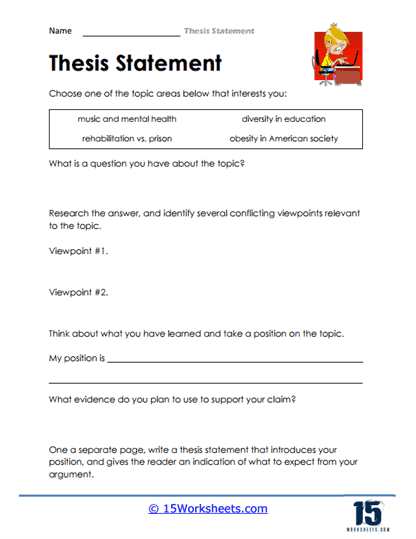
Interesting Topics
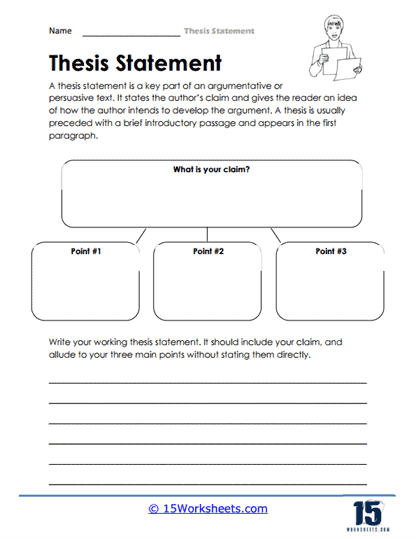
Claim And Points
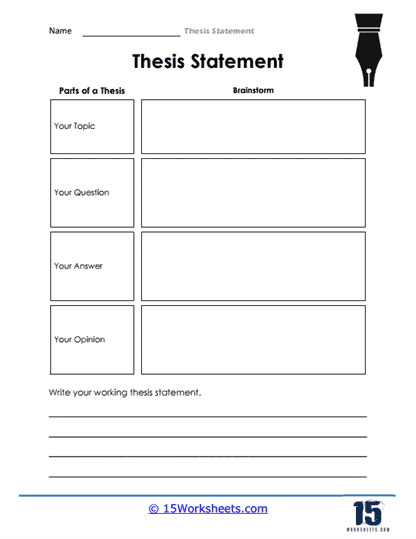
Breaking It Down
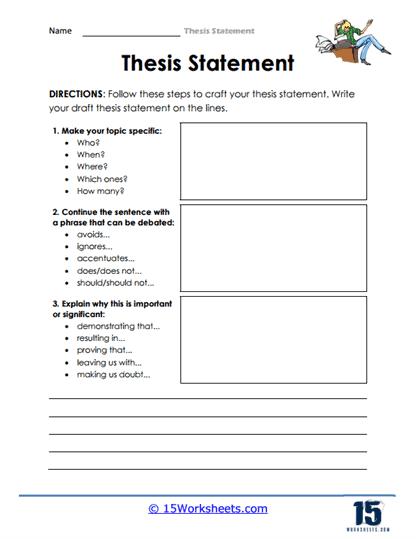
Follow The Steps
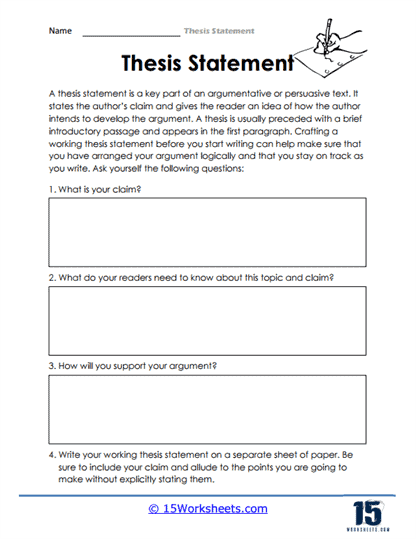
Craft The Key Part
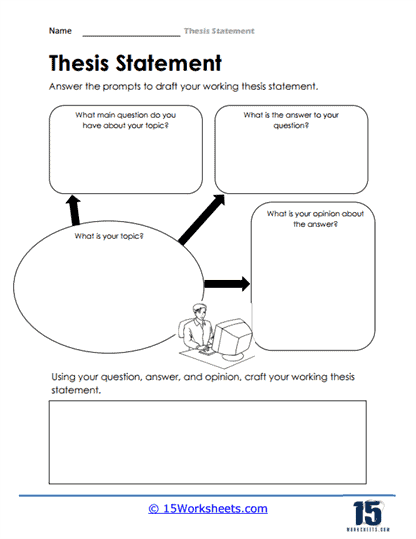
Answer The Prompts
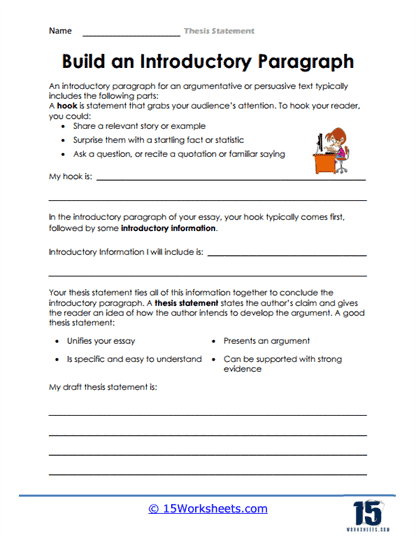
Build The Introductory
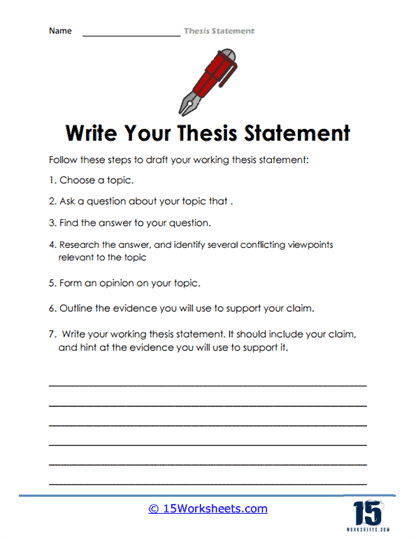
Step-By-Step Guide
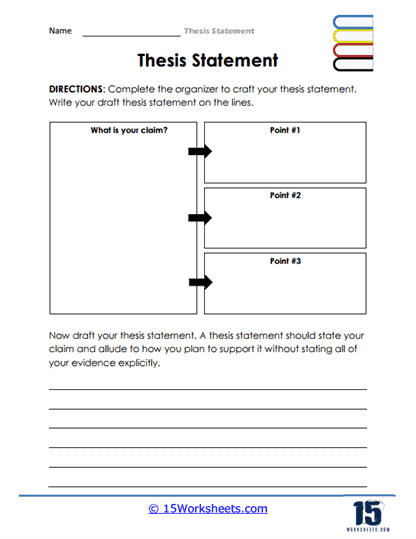
Complete The Organizer
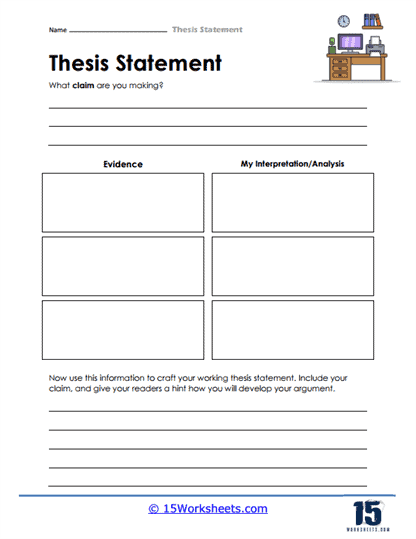
Your Interpretation
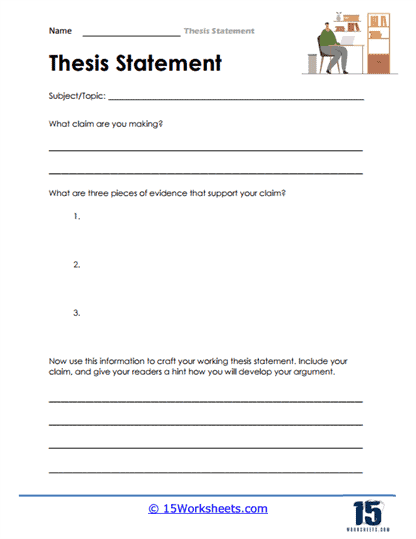
Give A Hint
All about these 15 worksheets.
This series of 15 worksheets offers an invaluable resource for students to master the art of creating compelling thesis statements. These meticulously designed worksheets provide step-by-step guidance to help students develop clear, focused, and persuasive thesis statements that form the backbone of their essays and arguments.
The varied writing prompts empower students to become proficient in articulating their main arguments concisely and effectively. Through a series of engaging exercises, students will learn the importance of a strong thesis statement in guiding their writing and influencing readers’ understanding and engagement. Through these worksheets, students will:
- Learn how a well-crafted thesis statement serves as a roadmap, guiding the organization and development of their essays;
- Learn the importance of clarity, specificity, and arguability in constructing effective thesis statements;
- Differentiate thesis statements from topic sentences;
- Refine their ability to express complex ideas in a clear and focused manner;
- And practice incorporating strong thesis statements into their essays, arguments, and persuasive pieces.
This series equips students with the skills necessary to craft compelling and influential thesis statements. By mastering the art of thesis statement writing, they enhance their critical thinking, persuasive writing, and organization skills, setting a strong foundation for their academic and professional endeavors.
Whether used in language arts classrooms, essay writing workshops, or as part of independent study, these Thesis Statements worksheets provide an invaluable resource for students to become proficient in developing clear, focused, and persuasive thesis statements.
How To Write A Thesis Statement
A thesis statement is very important for an essay. It summarizes your point or opinion on the subject in a single line. A thesis statement should be clear, concise, and strong, as all points in the essay will need to relate to it. Without a thesis statement, your essay will fall flat and lack information crucial to hook the reader. The thesis statement is also added at the end of the introduction and is a must-have if you want to persuade your reader.
Brainstorm Your Topic
The first step in writing a thesis statement is brainstorming. This step could vary depending on if the topic was already provided or not and the type of essay. Once the topic has been decided, ask questions, such as:
- Why are you choosing this topic?
- Is there relevant information available on the internet?
- Can you target the topic to a particular audience?
At this point, your topic is just a title and not a statement. The more questions you ask, the more specified and coherent your thesis statement will be.
Take Your Stance
After finalizing the topic, pick your stance on it. What’s your opinion about the topic? Do you oppose the idea or support it? You can provide a tentative answer over here and research to solidify your position on the subject.
Provide Supporting Ideas
Whether you support or oppose the subject, you need to research and mention key points here. Give your reasons with facts and figures about why you support/oppose this subject. It’s best to provide 3 to 4 supporting ideas to persuade the audience.
Include an Opposing Viewpoint
This is not a must-have in every thesis statement, but acknowledging the opposing point of view can significantly impact the statement. Adding counterarguments or issues that people might have with your statement will help both types of readers relate to the topic, thus, widening your reach.
Now that you know how to write a thesis statement, let’s look at the qualities of a good thesis statement and some examples.
Qualities of a Good Thesis Statement
Strong Stance
A good thesis statement includes a strong stance. You need to decide your position on the matter and stick to it throughout the essay. Also, try to be specific with your position and target a particular audience.
Encourages Discussion
Your thesis statement needs to encourage discussions. It can’t be a simple fact everyone knows and can’t disagree with. It should have to support opposing views so readers can change their minds.
One Main Idea
Your thesis statement should be clear and coherent. It needs to display one main idea. Even though there will be many supporting points and reasons throughout the essay, they should all link back to the main statement.
Examples of Good Thesis Statements
“Because many children are unable to vaccinate as a result of illness, all healthy and able children should be vaccinated to start the development of herd immunity.”
Libraries serve as essential resources for various communities. As such, they should have better funding from local municipalities.
Reading Worksheets, Spelling, Grammar, Comprehension, Lesson Plans
How to Write a Thesis Statement
About this worksheet:.
Practice developing thesis statements with this writing introduction worksheet! Students will learn how to improve their writing with a strong, attention grabbing thesis statement. This activity helps build writing skills by asking students to create a statement for the topics provided, such as: “What was the greatest challenge in your life?”.
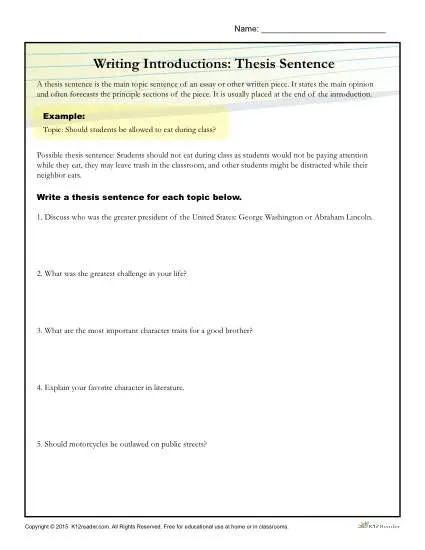

Thesis Statements
What this handout is about.
This handout describes what a thesis statement is, how thesis statements work in your writing, and how you can craft or refine one for your draft.
Introduction
Writing in college often takes the form of persuasion—convincing others that you have an interesting, logical point of view on the subject you are studying. Persuasion is a skill you practice regularly in your daily life. You persuade your roommate to clean up, your parents to let you borrow the car, your friend to vote for your favorite candidate or policy. In college, course assignments often ask you to make a persuasive case in writing. You are asked to convince your reader of your point of view. This form of persuasion, often called academic argument, follows a predictable pattern in writing. After a brief introduction of your topic, you state your point of view on the topic directly and often in one sentence. This sentence is the thesis statement, and it serves as a summary of the argument you’ll make in the rest of your paper.
What is a thesis statement?
A thesis statement:
- tells the reader how you will interpret the significance of the subject matter under discussion.
- is a road map for the paper; in other words, it tells the reader what to expect from the rest of the paper.
- directly answers the question asked of you. A thesis is an interpretation of a question or subject, not the subject itself. The subject, or topic, of an essay might be World War II or Moby Dick; a thesis must then offer a way to understand the war or the novel.
- makes a claim that others might dispute.
- is usually a single sentence near the beginning of your paper (most often, at the end of the first paragraph) that presents your argument to the reader. The rest of the paper, the body of the essay, gathers and organizes evidence that will persuade the reader of the logic of your interpretation.
If your assignment asks you to take a position or develop a claim about a subject, you may need to convey that position or claim in a thesis statement near the beginning of your draft. The assignment may not explicitly state that you need a thesis statement because your instructor may assume you will include one. When in doubt, ask your instructor if the assignment requires a thesis statement. When an assignment asks you to analyze, to interpret, to compare and contrast, to demonstrate cause and effect, or to take a stand on an issue, it is likely that you are being asked to develop a thesis and to support it persuasively. (Check out our handout on understanding assignments for more information.)
How do I create a thesis?
A thesis is the result of a lengthy thinking process. Formulating a thesis is not the first thing you do after reading an essay assignment. Before you develop an argument on any topic, you have to collect and organize evidence, look for possible relationships between known facts (such as surprising contrasts or similarities), and think about the significance of these relationships. Once you do this thinking, you will probably have a “working thesis” that presents a basic or main idea and an argument that you think you can support with evidence. Both the argument and your thesis are likely to need adjustment along the way.
Writers use all kinds of techniques to stimulate their thinking and to help them clarify relationships or comprehend the broader significance of a topic and arrive at a thesis statement. For more ideas on how to get started, see our handout on brainstorming .
How do I know if my thesis is strong?
If there’s time, run it by your instructor or make an appointment at the Writing Center to get some feedback. Even if you do not have time to get advice elsewhere, you can do some thesis evaluation of your own. When reviewing your first draft and its working thesis, ask yourself the following :
- Do I answer the question? Re-reading the question prompt after constructing a working thesis can help you fix an argument that misses the focus of the question. If the prompt isn’t phrased as a question, try to rephrase it. For example, “Discuss the effect of X on Y” can be rephrased as “What is the effect of X on Y?”
- Have I taken a position that others might challenge or oppose? If your thesis simply states facts that no one would, or even could, disagree with, it’s possible that you are simply providing a summary, rather than making an argument.
- Is my thesis statement specific enough? Thesis statements that are too vague often do not have a strong argument. If your thesis contains words like “good” or “successful,” see if you could be more specific: why is something “good”; what specifically makes something “successful”?
- Does my thesis pass the “So what?” test? If a reader’s first response is likely to be “So what?” then you need to clarify, to forge a relationship, or to connect to a larger issue.
- Does my essay support my thesis specifically and without wandering? If your thesis and the body of your essay do not seem to go together, one of them has to change. It’s okay to change your working thesis to reflect things you have figured out in the course of writing your paper. Remember, always reassess and revise your writing as necessary.
- Does my thesis pass the “how and why?” test? If a reader’s first response is “how?” or “why?” your thesis may be too open-ended and lack guidance for the reader. See what you can add to give the reader a better take on your position right from the beginning.
Suppose you are taking a course on contemporary communication, and the instructor hands out the following essay assignment: “Discuss the impact of social media on public awareness.” Looking back at your notes, you might start with this working thesis:
Social media impacts public awareness in both positive and negative ways.
You can use the questions above to help you revise this general statement into a stronger thesis.
- Do I answer the question? You can analyze this if you rephrase “discuss the impact” as “what is the impact?” This way, you can see that you’ve answered the question only very generally with the vague “positive and negative ways.”
- Have I taken a position that others might challenge or oppose? Not likely. Only people who maintain that social media has a solely positive or solely negative impact could disagree.
- Is my thesis statement specific enough? No. What are the positive effects? What are the negative effects?
- Does my thesis pass the “how and why?” test? No. Why are they positive? How are they positive? What are their causes? Why are they negative? How are they negative? What are their causes?
- Does my thesis pass the “So what?” test? No. Why should anyone care about the positive and/or negative impact of social media?
After thinking about your answers to these questions, you decide to focus on the one impact you feel strongly about and have strong evidence for:
Because not every voice on social media is reliable, people have become much more critical consumers of information, and thus, more informed voters.
This version is a much stronger thesis! It answers the question, takes a specific position that others can challenge, and it gives a sense of why it matters.
Let’s try another. Suppose your literature professor hands out the following assignment in a class on the American novel: Write an analysis of some aspect of Mark Twain’s novel Huckleberry Finn. “This will be easy,” you think. “I loved Huckleberry Finn!” You grab a pad of paper and write:
Mark Twain’s Huckleberry Finn is a great American novel.
You begin to analyze your thesis:
- Do I answer the question? No. The prompt asks you to analyze some aspect of the novel. Your working thesis is a statement of general appreciation for the entire novel.
Think about aspects of the novel that are important to its structure or meaning—for example, the role of storytelling, the contrasting scenes between the shore and the river, or the relationships between adults and children. Now you write:
In Huckleberry Finn, Mark Twain develops a contrast between life on the river and life on the shore.
- Do I answer the question? Yes!
- Have I taken a position that others might challenge or oppose? Not really. This contrast is well-known and accepted.
- Is my thesis statement specific enough? It’s getting there–you have highlighted an important aspect of the novel for investigation. However, it’s still not clear what your analysis will reveal.
- Does my thesis pass the “how and why?” test? Not yet. Compare scenes from the book and see what you discover. Free write, make lists, jot down Huck’s actions and reactions and anything else that seems interesting.
- Does my thesis pass the “So what?” test? What’s the point of this contrast? What does it signify?”
After examining the evidence and considering your own insights, you write:
Through its contrasting river and shore scenes, Twain’s Huckleberry Finn suggests that to find the true expression of American democratic ideals, one must leave “civilized” society and go back to nature.
This final thesis statement presents an interpretation of a literary work based on an analysis of its content. Of course, for the essay itself to be successful, you must now present evidence from the novel that will convince the reader of your interpretation.
Works consulted
We consulted these works while writing this handout. This is not a comprehensive list of resources on the handout’s topic, and we encourage you to do your own research to find additional publications. Please do not use this list as a model for the format of your own reference list, as it may not match the citation style you are using. For guidance on formatting citations, please see the UNC Libraries citation tutorial . We revise these tips periodically and welcome feedback.
Anson, Chris M., and Robert A. Schwegler. 2010. The Longman Handbook for Writers and Readers , 6th ed. New York: Longman.
Lunsford, Andrea A. 2015. The St. Martin’s Handbook , 8th ed. Boston: Bedford/St Martin’s.
Ramage, John D., John C. Bean, and June Johnson. 2018. The Allyn & Bacon Guide to Writing , 8th ed. New York: Pearson.
Ruszkiewicz, John J., Christy Friend, Daniel Seward, and Maxine Hairston. 2010. The Scott, Foresman Handbook for Writers , 9th ed. Boston: Pearson Education.
You may reproduce it for non-commercial use if you use the entire handout and attribute the source: The Writing Center, University of North Carolina at Chapel Hill
Make a Gift
Think of yourself as a member of a jury, listening to a lawyer who is presenting an opening argument. You'll want to know very soon whether the lawyer believes the accused to be guilty or not guilty, and how the lawyer plans to convince you. Readers of academic essays are like jury members: before they have read too far, they want to know what the essay argues as well as how the writer plans to make the argument. After reading your thesis statement, the reader should think, "This essay is going to try to convince me of something. I'm not convinced yet, but I'm interested to see how I might be."
An effective thesis cannot be answered with a simple "yes" or "no." A thesis is not a topic; nor is it a fact; nor is it an opinion. "Reasons for the fall of communism" is a topic. "Communism collapsed in Eastern Europe" is a fact known by educated people. "The fall of communism is the best thing that ever happened in Europe" is an opinion. (Superlatives like "the best" almost always lead to trouble. It's impossible to weigh every "thing" that ever happened in Europe. And what about the fall of Hitler? Couldn't that be "the best thing"?)
A good thesis has two parts. It should tell what you plan to argue, and it should "telegraph" how you plan to argue—that is, what particular support for your claim is going where in your essay.
Steps in Constructing a Thesis
First, analyze your primary sources. Look for tension, interest, ambiguity, controversy, and/or complication. Does the author contradict himself or herself? Is a point made and later reversed? What are the deeper implications of the author's argument? Figuring out the why to one or more of these questions, or to related questions, will put you on the path to developing a working thesis. (Without the why, you probably have only come up with an observation—that there are, for instance, many different metaphors in such-and-such a poem—which is not a thesis.)
Once you have a working thesis, write it down. There is nothing as frustrating as hitting on a great idea for a thesis, then forgetting it when you lose concentration. And by writing down your thesis you will be forced to think of it clearly, logically, and concisely. You probably will not be able to write out a final-draft version of your thesis the first time you try, but you'll get yourself on the right track by writing down what you have.
Keep your thesis prominent in your introduction. A good, standard place for your thesis statement is at the end of an introductory paragraph, especially in shorter (5-15 page) essays. Readers are used to finding theses there, so they automatically pay more attention when they read the last sentence of your introduction. Although this is not required in all academic essays, it is a good rule of thumb.
Anticipate the counterarguments. Once you have a working thesis, you should think about what might be said against it. This will help you to refine your thesis, and it will also make you think of the arguments that you'll need to refute later on in your essay. (Every argument has a counterargument. If yours doesn't, then it's not an argument—it may be a fact, or an opinion, but it is not an argument.)
This statement is on its way to being a thesis. However, it is too easy to imagine possible counterarguments. For example, a political observer might believe that Dukakis lost because he suffered from a "soft-on-crime" image. If you complicate your thesis by anticipating the counterargument, you'll strengthen your argument, as shown in the sentence below.
Some Caveats and Some Examples
A thesis is never a question. Readers of academic essays expect to have questions discussed, explored, or even answered. A question ("Why did communism collapse in Eastern Europe?") is not an argument, and without an argument, a thesis is dead in the water.
A thesis is never a list. "For political, economic, social and cultural reasons, communism collapsed in Eastern Europe" does a good job of "telegraphing" the reader what to expect in the essay—a section about political reasons, a section about economic reasons, a section about social reasons, and a section about cultural reasons. However, political, economic, social and cultural reasons are pretty much the only possible reasons why communism could collapse. This sentence lacks tension and doesn't advance an argument. Everyone knows that politics, economics, and culture are important.
A thesis should never be vague, combative or confrontational. An ineffective thesis would be, "Communism collapsed in Eastern Europe because communism is evil." This is hard to argue (evil from whose perspective? what does evil mean?) and it is likely to mark you as moralistic and judgmental rather than rational and thorough. It also may spark a defensive reaction from readers sympathetic to communism. If readers strongly disagree with you right off the bat, they may stop reading.
An effective thesis has a definable, arguable claim. "While cultural forces contributed to the collapse of communism in Eastern Europe, the disintegration of economies played the key role in driving its decline" is an effective thesis sentence that "telegraphs," so that the reader expects the essay to have a section about cultural forces and another about the disintegration of economies. This thesis makes a definite, arguable claim: that the disintegration of economies played a more important role than cultural forces in defeating communism in Eastern Europe. The reader would react to this statement by thinking, "Perhaps what the author says is true, but I am not convinced. I want to read further to see how the author argues this claim."
A thesis should be as clear and specific as possible. Avoid overused, general terms and abstractions. For example, "Communism collapsed in Eastern Europe because of the ruling elite's inability to address the economic concerns of the people" is more powerful than "Communism collapsed due to societal discontent."
Copyright 1999, Maxine Rodburg and The Tutors of the Writing Center at Harvard University

- University of Pennsylvania
- School of Arts and Sciences
- Penn Calendar
Search form

Thesis and Introduction Worksheet
Katherine milligan.
Thesis Guidelines Your thesis should...
... make an argument regarding your topic
Tender Buttons
... consist of a strong statement
Sample Thesis Statements
There are many similarities and differences between Humbert Humbert and Clare Quilty.
Throughout history, men have written about lusting after women; Lolita is no exception.
Morality is not the issue in Lolita ; artistry is.
Lolita is a novel about America.
Lolita is a novel about the corruption of America.
In Lolita , the corruption of America merely provides a convenient cover-up for Humbert Humbert's personal perversion.
Lolita is an interesting novel, although the narrator, Humbert Humbert, is evil.
Love is dead in the twentieth century novel.
Although World War II is never mentioned in Lolita , its influence on American society motivates the novel.
Introduction Guidelines Your introduction should...
... lay the logical foundation for your paper.
... hook your reader. mandatory
Sample Introductions
There are many similarities and differences between the characters of Humbert Humbert and Clare Quilty. By examining these similarities and differences, several important ideas can be seen. Both characters are obsessive and paranoid, but Quilty is more successful than Humbert.
Throughout history, men have written about lusting after women. In the novel "Lolita" by Vladimir Nabokov, the main character is seduced by a nymphet, Dolores Haze. He has always been attracted to nymphets due to a traumatic experience with his first love, Annabel, when he was young himself. After Lolita's mother dies, he has her all to himself, and they take two trips across the country, staying in motels and sightseeing. In the end, he is deceived by Lolita, who runs away with Quilty and later gets pregnant and marries someone else. This demonstrates how love is always doomed to failure, since his possession of her was always an illusion.
In his essay "On a Book Entitled Lolita," Vladimir Nabokov writes that his novel has "no moral in tow" (314). Regardless of whether we agree with Nabokov, reducing Lolita to a discussion of moral issues misses the point. Lolita is a work of fiction and must be treated as such. The first few pages of the novel establish this point beyond the shadow of a doubt by alluding to such literary predecessors as Poe, Merimee, Dante, Proust, and Keats. Without understanding these allusions, the novel itself cannot be understood.
Is Lolita a love story? Answering this question in the affirmative requires a redefinition of the term "love." After all, Humbert Humbert causes more misery than joy to the object of his affections. Lolita's suffering, both mental and physical, is apparent throughout the novel. And yet Humbert's obsession with her goes beyond mere lust or passion. He is both tender and constant in his affections. As a close examination of the end of the novel will show, Humbert Humbert is a lover as well as a rapist.
Purdue Online Writing Lab Purdue OWL® College of Liberal Arts
Tips and Examples for Writing Thesis Statements

Welcome to the Purdue OWL
This page is brought to you by the OWL at Purdue University. When printing this page, you must include the entire legal notice.
Copyright ©1995-2018 by The Writing Lab & The OWL at Purdue and Purdue University. All rights reserved. This material may not be published, reproduced, broadcast, rewritten, or redistributed without permission. Use of this site constitutes acceptance of our terms and conditions of fair use.
Tips for Writing Your Thesis Statement
1. Determine what kind of paper you are writing:
- An analytical paper breaks down an issue or an idea into its component parts, evaluates the issue or idea, and presents this breakdown and evaluation to the audience.
- An expository (explanatory) paper explains something to the audience.
- An argumentative paper makes a claim about a topic and justifies this claim with specific evidence. The claim could be an opinion, a policy proposal, an evaluation, a cause-and-effect statement, or an interpretation. The goal of the argumentative paper is to convince the audience that the claim is true based on the evidence provided.
If you are writing a text that does not fall under these three categories (e.g., a narrative), a thesis statement somewhere in the first paragraph could still be helpful to your reader.
2. Your thesis statement should be specific—it should cover only what you will discuss in your paper and should be supported with specific evidence.
3. The thesis statement usually appears at the end of the first paragraph of a paper.
4. Your topic may change as you write, so you may need to revise your thesis statement to reflect exactly what you have discussed in the paper.
Thesis Statement Examples
Example of an analytical thesis statement:
The paper that follows should:
- Explain the analysis of the college admission process
- Explain the challenge facing admissions counselors
Example of an expository (explanatory) thesis statement:
- Explain how students spend their time studying, attending class, and socializing with peers
Example of an argumentative thesis statement:
- Present an argument and give evidence to support the claim that students should pursue community projects before entering college
- My Storyboards
Thesis Statement Worksheet Templates
Customize thesis statement templates.
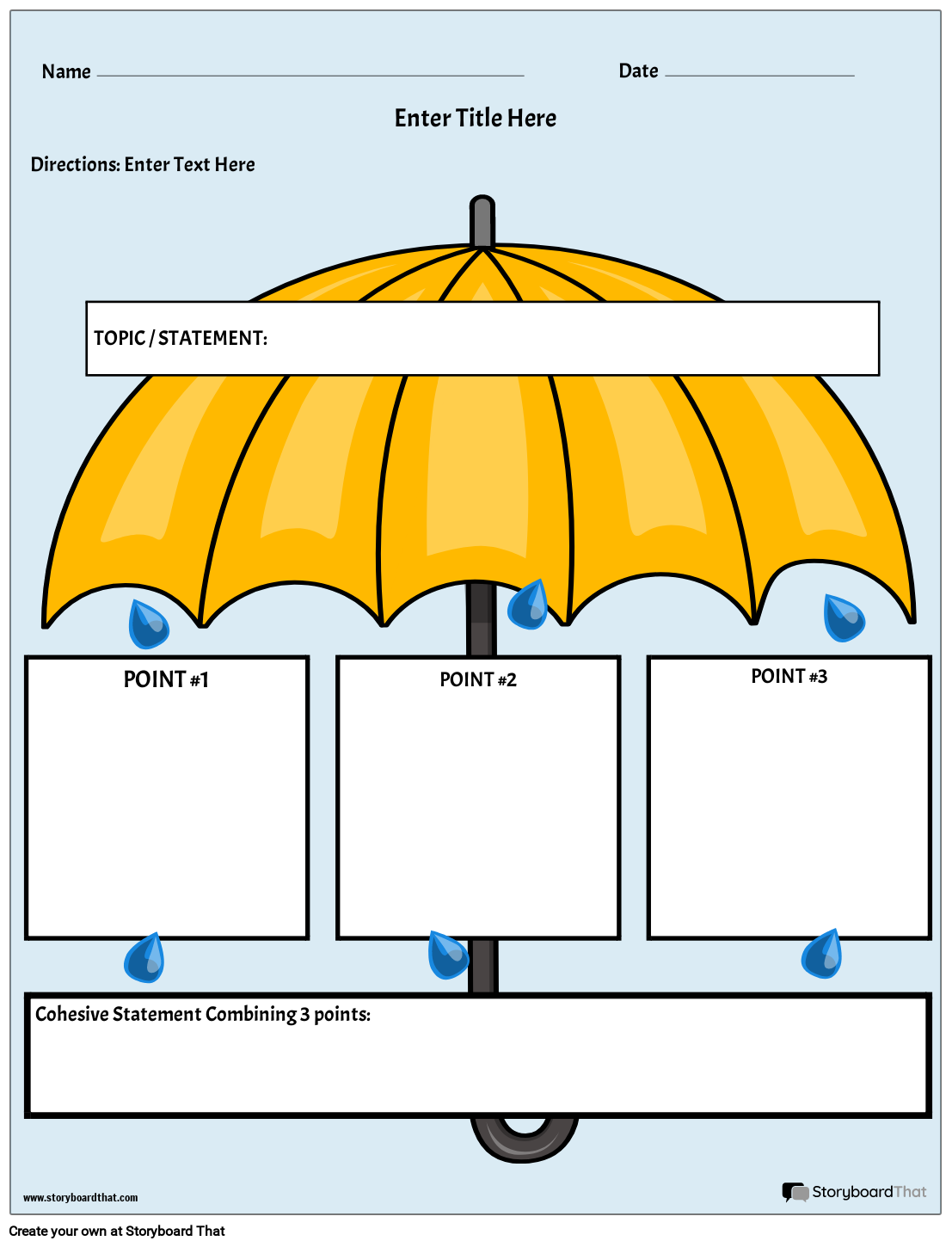
If you're assigning this to your students, copy the worksheet to your account and save. When creating an assignment, just select it as a template!

What is a Thesis Statement?
In academic writing, a thesis statement is the central idea, claim, or argument that guides the entire paper. Knowing how to write a one is essential for creating strong and coherent papers that convey your message effectively. However, crafting an effective statement is not easy and can be a daunting task for many writers, regardless of the subject. Our templates provide a structured framework for students to create well-crafted thesis statements that meet the requirements of academic writing.

What is a Thesis Statement Worksheet?
Our worksheets help plan for any essay or paper. Students can use a specific (enumerative) thesis statement or an umbrella thesis statement to plan out the primary idea of their essay and practice writing effective ideas. Academic writing often requires a strong statement that sets the tone and purpose of the work.
Why Are These Graphic Organizers Important and How Are They Best Used?
Thesis statements are the bedrock for any paper, debate, or other writing assignment. It is used to guide the writing and keep ideas focused on proving that statement true with relevant evidence. Students often have a difficult time getting started, so these templates can help guide them as they craft one to guide their writing. By using a template, learners can structure their thoughts and ideas to create something that is clear, concise, and effective. Outlines provide a framework for writers to understand the different types, generate ideas, and effectively communicate their message. Additionally, graphic organizers offer a visual way to organize ideas, making the process of writing more accessible for learners.
There are different types of worksheets that are designed for different purposes and levels of writing proficiency. Some worksheets may be geared towards helping students develop a basic understanding of how to get started, while others may be more advanced and focused on refining and strengthening existing pieces of writing. Having different templates gives students a choice on which is most useful for their task.
Other Useful Tips for Creating Successful/Useful Thesis Statements Organizer Worksheets
Using worksheet templates can be a powerful tool for helping kids craft strong and effective writing. By providing a structured framework for organizing ideas, learners can better understand the key elements and how to write one effectively. A graphic organizer example can help learners understand the different categories, such as argumentative, analytical, or expository, and how to write a something that fits within these categories.
Graphic organizer examples offer visual representations for parts such as the topic, argument, and main points. This approach can be particularly useful for visual learners who may struggle with written instructions. Templates also allow for differentiation of instruction for learners with different skill levels. For example, some templates may be more structured for learners who are just beginning to learn this type of writing, while others may allow for more flexibility and creativity for more advanced learners.
Using a template can also help learners to better understand the purpose of what they are writing. By breaking down the different components, learners have the space to see how their thesis statement relates to the broader context of their paper and how it guides the reader towards their argument or main point. Overall, worksheet templates can be an effective way to support learners with different learning styles and skill levels and help them to master the art of writing a strong and effective thesis statement.
How to Make A Good Thesis Statement
While a worksheet can be a helpful tool for developing your writing skills, it is not a substitute for careful reading, research, and critical thinking. When using a planning worksheet, it is important to carefully read and follow the instructions and prompts provided. Pay attention to the specific requirements of the assignment, such as the length and format of the thesis statement, as well as the audience and purpose of the writing. Be prepared to revise and refine as needed, based on feedback from your instructor or other readers.
Planning templates are effective by guiding writers through a series of prompts or questions that help them develop a clear and focused argument for their writing assignment. Typically, the worksheet will begin by asking the student to identify the topic of their paper and narrow it down to a specific focus.
The prompts may then ask the student to consider different aspects of their argument, such as the key points they want to make, the evidence they will use to support their claims, and the counterarguments or objections they may need to address. Some worksheets may also provide examples and offer tips for crafting a strong and persuasive argument.
As the student works through the prompts, they will begin to develop a more refined and focused statement that effectively communicates the main argument of their paper. They may also receive feedback or suggestions for improvement from their instructor or peers, which they can use to revise and refine further.
Graphic Organizer Worksheets
Tips to consider when making your worksheet:
- Define the purpose and goals of the worksheet. Determine what specific skills or concepts you want your students to develop and what types of writing assignments they will be working on.
- Choose appropriate prompts or questions. Develop a series of prompts or questions that guide learners through the process of developing a clear and focused thesis statement. The prompts should be clear, concise, and relevant to the specific writing assignment.
- Provide examples and feedback. Offer examples and provide feedback and suggestions for improvement to help students refine their writing skills.
- Consider the needs of different learners. Be sure to consider the needs of different types of learners, such as visual, auditory, and kinesthetic learners, and include a variety of activities and strategies to engage all learners.
- Test and revise the worksheet. Try out the worksheet with a small group and gather feedback to identify any areas that may need to be revised or clarified.
- Provide instruction and support. Introduce the worksheet to your class and provide clear instructions and support as they work through the prompts and activities.
- Monitor progress and provide feedback. Monitor progress and provide ongoing feedback and support to help develop writing skills.
Free Thesis Statement Worksheets With Storyboard That
Storyboard That is not just a classroom label maker, it's also a versatile tool that can be used as a thesis statement generator free or even to create various educational resources. With the thesis statement maker, you can easily create templates that guide students in crafting strong and clear thesis statements. Simply choose a template and click on the elements to customize them according to your needs. Once done, you can save the worksheet and either print it right away or keep it in your storyboard library for later use. Whether you need to create free thesis statement worksheets, a specific type of thesis statement, or a general guide to writing thesis statements, Storyboard That's thesis statement creator can help simplify the process and provide a clear and structured framework for kids to follow.
How to Make a Thesis Statement Worksheet
Choose one of the premade templates.
We have lots of templates to choose from. Take a look at our example for inspiration!
Click on "Copy Template"
Once you do this, you will be directed to the storyboard creator.
Give Your Worksheet a Name!
Be sure to call it something related to the topic so that you can easily find it in the future.
Edit Your Worksheet
This is where you will include directions, specific questions and images, and make any aesthetic changes that you would like. The options are endless!
Click "Save and Exit"
When you are finished with your worksheet, click this button in the lower right hand corner to exit your storyboard.
From here you can print, download as a PDF, attach it to an assignment and use it digitally, and more!
Related Storyboard That Resources and Printables
- Essay Outline Worksheets
- Long Composition Template
- Outline Template Worksheets
- Sequencing Worksheets
Happy Creating!
Frequently Asked Questions about Thesis Statements
Do i need a worksheet to figure out how to write a thesis statement.
While you don't necessarily need a worksheet to write a thesis statement, a worksheet can help you organize your thoughts and ensure that your thesis statement is strong and effective. Worksheets can provide prompts, examples, and feedback to guide you through the process of how to create a thesis statement that works. They can also help students to work through various examples of both strong and weak thesis statements, and help develop their ability to recognize the characteristics of effective thesis statements, such as clarity, specificity, and a clear argumentative focus. Additionally, the exercises facilitated by the worksheets can help students understand how to develop a thesis statement that effectively guides their writing and provides a strong foundation for their argument. Through the use of example exercises worksheets, students can improve their critical thinking skills and gain confidence in their ability to craft a strong thesis statement.
What is an umbrella thesis statement?
An umbrella thesis statement is a broad statement that encompasses the main point of a paper without providing specific details or evidence. It is called an "umbrella" because it covers a large topic or issue that can be broken down into smaller subtopics for further exploration. An example of an umbrella thesis statement is "The impact of technology on society." Umbrella thesis examples can be an effective tool for teaching students about the importance of clarity and specificity in thesis statements. By using umbrella thesis examples, students can see how a broad topic can be narrowed down into a specific statement that provides a clear direction for the paper. This can help students understand how to craft a thesis statement that is both focused and specific, while still allowing for flexibility in their argument.
How do the worksheets help me to figure out how to make a thesis statement?
Thesis statement exercises worksheets are meant to help students to organize their thoughts and ideas before they begin to write a thesis statement. Worksheets help by providing clear and concise prompts, examples, and support, and helps students to understand the key components of a strong thesis statement and to develop their own unique ideas and arguments. Through the use of a worksheet, students are able to refine their ideas and ensure that their thesis statement accurately reflects the content of their essay or research paper. Ultimately, the worksheet serves as a valuable guide that helps students to write a clear and effective thesis statement.
Try 1 Month For
30 Day Money Back Guarantee New Customers Only Full Price After Introductory Offer
Learn more about our Department, School, and District packages

- Thousands of images
- Custom layouts, scenes, characters
- And so much more!!
Create a Storyboard
- Skip to primary navigation
- Skip to main content
- Skip to primary sidebar
Activities to Teach How to Write A Thesis Statement
Research Writing , Secondary Literacy , Writing
If there’s any literacy skill you would want your English Language Arts students to master, it would probably be how to write a thesis statement . If you want to teach your students how to write powerful, eloquent, and exceptionally captivating thesis statements, then you’ll love the activities in this article.
The key to any good essay is a strong thesis statement. A strong thesis statement sets the tone and clarifies the author’s purpose : it tells you the writer’s opinion, along with the level of thought and criticism that has gone into formulating it.
A strong thesis statement also creates an alluring introduction paragraph. This makes each paper in your grading pile a lot more inviting.
How do you teach students to write a thesis statement to make their audience continue reading? This blog post explores six activities to teach how to write a thesis statement.

1. Differentiate Between Strong and Weak Thesis Statements
Writing a thesis statement might be a new skill for your students. Thesis statements are often taught as a topic sentence or the “whole essay boiled down into one sentence.” This can be a challenging concept for your students to grasp.
To teach how to write a thesis statement, have a discussion about what makes a strong thesis statement. You can turn this into a collaborative lesson by brainstorming clarifying statements ; these statements dictate what a thesis is and is not.
For example: “ A proper thesis statement is written in one sentence ,” or “ a proper thesis statement is directly related to the rest of the essay .” This is a great opportunity to teach students the difference between concepts like a “topic sentence” or a “hook.”
Your students can use this free bookmark to differentiate between a strong thesis statement and a weak one. This slideshow lesson also explores clarifying statements with detailed examples.

2. Evaluate Thesis Statement Examples
Now that students have plenty of guidelines, challenge their understanding by evaluating thesis statement examples . You can use thesis statement examples from past students’ essays. You can even write your own examples based on the clarifying statements you create with your class.
If you’re open to your students receiving constructive, anonymous criticism , you can even have them write a thesis statement and evaluate each one as a class. I’ve had success with providing students with a thesis statement topic and having them write a thesis statement. Then, I prompt them to swap with their elbow partner to offer feedback.
If you’d rather provide a comprehensive list of thesis statements that reflect the common errors you would typically see in students’ essays, there are several student examples in this introductory lesson on how to write a thesis statement – this is one of my favourite activities for teaching thesis statement writing!
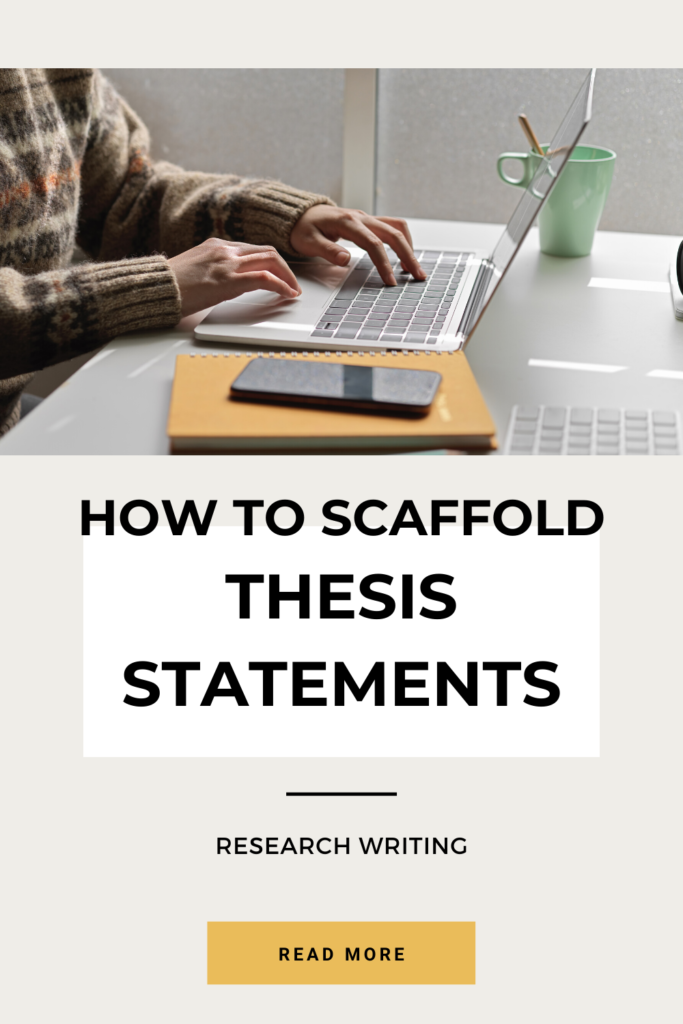
3. Provide a Thesis Statement Template
One of the easiest ways to teach how to write a thesis statement is to offer a thesis statement template . There are a variety of thesis statement templates that students can use as a framework for their essays. I start with a basic template that involves the three parts of a thesis statement: a topic, position, and evidence . I then demonstrate to students how they can create variations of this template, depending on which order they introduce each part. You can find examples for each template in these thesis statement handouts .
You can also introduce a few sentence styles to your students. These styles scaffold eloquent thesis statements. They also offer students the space to articulate their thoughts without exceeding the one-sentence limit.
Sentence Styles for the Three Parts of a Thesis Statement
Here are a few sentence styles that incorporate the three parts of a thesis statement. Each style also includes an example written by a real student:
- Style A : “Noun phrase; Noun phrase; Noun phrase – Independent Clause” Example: “The promotion of hygiene; the presence of medical professionals; the prevention of death – these are all reasons why supervised injection services are an important facet of public health.”
- Style B : If (subject + verb + object phrase), if (subject + verb + object phrase ), if (subject + verb + object phrase ), then (independent clause) Example: “If taxpayers do not wish to have their money allocated to cruelty, if more than 100 million animals die from animal testing a year, if alternatives to animal testing exist, then governments should ban the practice of testing on animals.”
- Style C : Independent clause: subject + verb, subject + verb, subject + verb Example: “College education should be entirely funded by the government: student debt would be eliminated, education would not be commodified, and access to education would not be exclusive to privileged people.”
All of these sentence styles are outlined in these practice worksheets for how to write a thesis statement, with writing prompts to reinforce each thesis statement template through repeated practice.
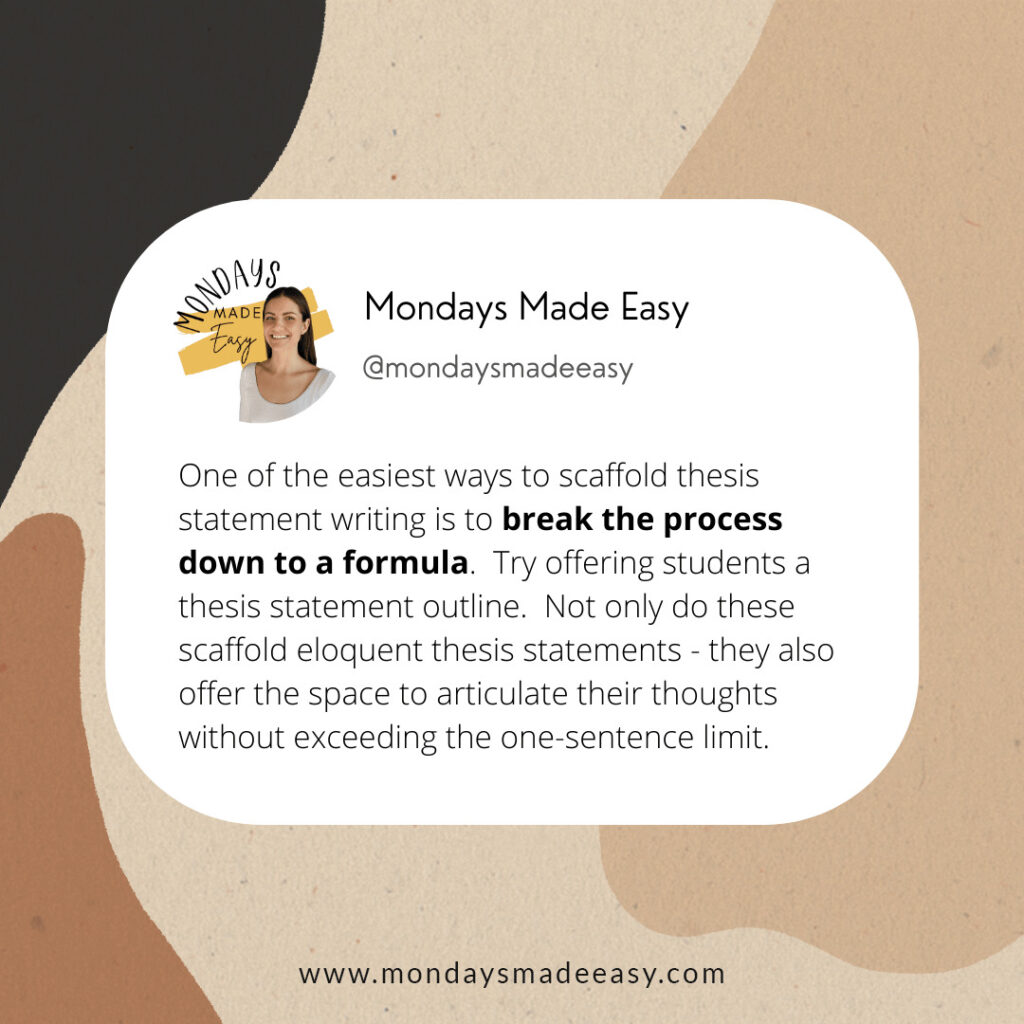
4. Daily Practice Activities to Teach How to Write a Thesis Statement
One of the most effective ways to teach how to write a thesis statement is through repeated practice. You can do this by incorporating daily bell ringers into your persuasive writing unit. To assign this activity, I provide students with three topics to choose from. I then prompt them to develop an opinion and write a thesis statement for one.
I’ll also include bell ringers that provide a thesis statement that students need to evaluate. Students really enjoy these drills! They get the opportunity to develop opinions on interesting topics, and many of them choose to explore these ideas as the subject of their final research paper.
If you’re looking for pre-made worksheets with thesis statement activities, these daily thesis statement bell ringers include one month’s worth of thesis statement prompts, graphic organizers, and templates in both digital and ready-to-print format.
5. Use a Self-Assessment Thesis Statement Anchor Chart
You can provide students with a thesis statement anchor chart to reference the guidelines and rules they’ve learned. A personalized anchor chart is best – like this free thesis statement bookmark – so that students can have it on hand while they are reading and writing.
You can distribute the anchor chart at the beginning of your research paper unit. Students can refer to it while evaluating thesis statement examples or completing daily practice activities. A thesis statement anchor chart has been a complete game-changer in my classroom, and I’m pleased to learn that many of my students have held on to these after completing my course.
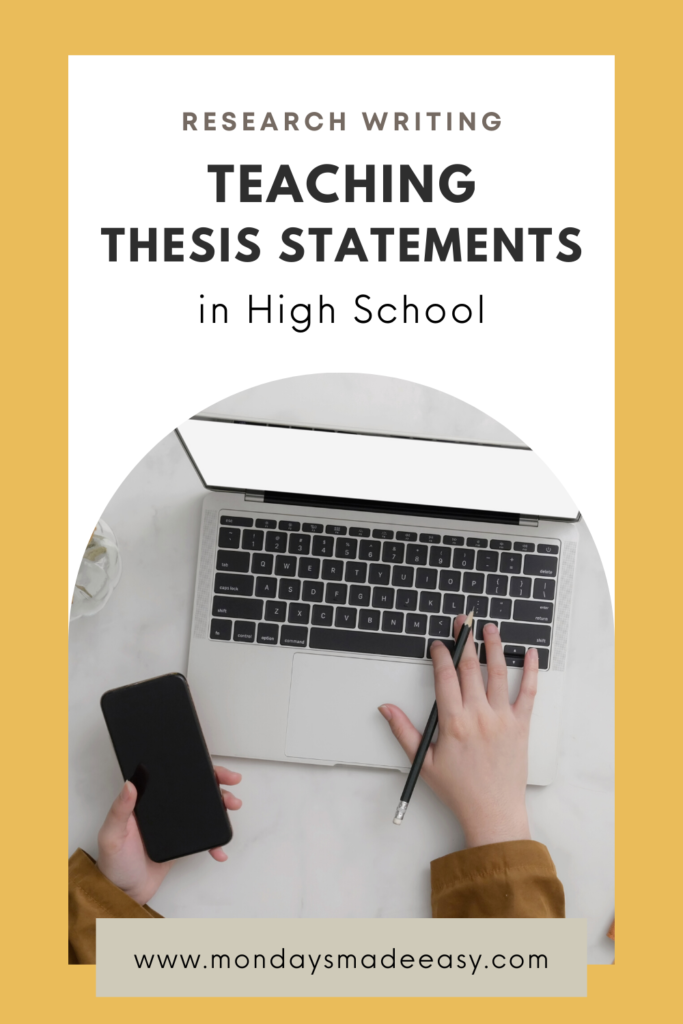
6. Provide Engaging Thesis Statement Topics
You can collaborate with your students to generate an engaging list of good topics for thesis statements. Start by writing down every topic that your students suggest. Then, you can narrow this list down to avoid broad, far-reaching thesis statements that lead to a watered-down essay. When I make this list with my students, we end up with topics that are truly engaging for them. I also have the opportunity to clarify which topics might be a little too vague or broad for an exceptional essay.
For example, students often suggest topics like “racism” or “the problem with school.” These are learning opportunities to demonstrate to students that a great thesis statement is the essential starting point for an even greater essay.
To elaborate, a topic like racism has different implications all over the world. It is far too complex to explore in a single, 750-word essay. Instead, we work together to narrow this topic down to something like “racism in the media,” or even better, “representation in Hollywood.”
Additionally, a topic like “the problem with school” is more of a conclusion. To solve this, we work backward to identify some of the aspects of our school that make it an obstacle . This can include uniforms, early starts, or cell phone policies. This process leads students to a more concise topic, like “cell phone policies in twenty-first-century schools.”
If you’re looking for engaging thesis statement topics to inspire your students, I’ve included a list of 75 argumentative essay topics in this practice unit for how to write a thesis statement .
Tying it All Together
There are plenty of fun thesis statement activities and practice lessons that you can incorporate into your curriculum. Give thesis statements the love and attention they deserve in the classroom – after all, they truly are the most important part of a research essay.
All of the worksheets, lessons, and activities explored in this blog post are included in Mondays Made Easy’s unit for teaching how to write a thesis statement . This bundle has everything you need to teach your students how to master their thesis statements and apply these essential literacy skills to their writing.

How to write a PhD thesis: a step-by-step guide
A draft isn’t a perfect, finished product; it is your opportunity to start getting words down on paper, writes Kelly Louise Preece
Kelly Louise Preece

Created in partnership with

You may also like

Popular resources
.css-1txxx8u{overflow:hidden;max-height:81px;text-indent:0px;} How to develop a researcher mindset as a PhD student
Formative, summative or diagnostic assessment a guide, emotions and learning: what role do emotions play in how and why students learn, how to assess and enhance students’ ai literacy, how hard can it be testing ai detection tools.
Congratulations; you’ve finished your research! Time to write your PhD thesis. This resource will take you through an eight-step plan for drafting your chapters and your thesis as a whole.

Organise your material
Before you start, it’s important to get organised. Take a step back and look at the data you have, then reorganise your research. Which parts of it are central to your thesis and which bits need putting to one side? Label and organise everything using logical folders – make it easy for yourself! Academic and blogger Pat Thomson calls this “Clean up to get clearer” . Thomson suggests these questions to ask yourself before you start writing:
- What data do you have? You might find it useful to write out a list of types of data (your supervisor will find this list useful too.) This list is also an audit document that can go in your thesis. Do you have any for the “cutting room floor”? Take a deep breath and put it in a separate non-thesis file. You can easily retrieve it if it turns out you need it.
- What do you have already written? What chunks of material have you written so far that could form the basis of pieces of the thesis text? They will most likely need to be revised but they are useful starting points. Do you have any holding text? That is material you already know has to be rewritten but contains information that will be the basis of a new piece of text.
- What have you read and what do you still need to read? Are there new texts that you need to consult now after your analysis? What readings can you now put to one side, knowing that they aren’t useful for this thesis – although they might be useful at another time?
- What goes with what? Can you create chunks or themes of materials that are going to form the basis of some chunks of your text, perhaps even chapters?
Once you have assessed and sorted what you have collected and generated you will be in much better shape to approach the big task of composing the dissertation.
Decide on a key message
A key message is a summary of new information communicated in your thesis. You should have started to map this out already in the section on argument and contribution – an overarching argument with building blocks that you will flesh out in individual chapters.
You have already mapped your argument visually, now you need to begin writing it in prose. Following another of Pat Thomson’s exercises, write a “tiny text” thesis abstract. This doesn’t have to be elegant, or indeed the finished product, but it will help you articulate the argument you want your thesis to make. You create a tiny text using a five-paragraph structure:
- The first sentence addresses the broad context. This locates the study in a policy, practice or research field.
- The second sentence establishes a problem related to the broad context you have set out. It often starts with “But”, “Yet” or “However”.
- The third sentence says what specific research has been done. This often starts with “This research” or “I report…”
- The fourth sentence reports the results. Don’t try to be too tricky here, just start with something like: “This study shows,” or “Analysis of the data suggests that…”
- The fifth and final sentence addresses the “So What?” question and makes clear the claim to contribution.
Here’s an example that Thomson provides:
Secondary school arts are in trouble, as the fall in enrolments in arts subjects dramatically attests. However, there is patchy evidence about the benefits of studying arts subjects at school and this makes it hard to argue why the drop in arts enrolments matters. This thesis reports on research which attempts to provide some answers to this problem – a longitudinal study which followed two groups of senior secondary students, one group enrolled in arts subjects and the other not, for three years. The results of the study demonstrate the benefits of young people’s engagement in arts activities, both in and out of school, as well as the connections between the two. The study not only adds to what is known about the benefits of both formal and informal arts education but also provides robust evidence for policymakers and practitioners arguing for the benefits of the arts. You can find out more about tiny texts and thesis abstracts on Thomson’s blog.
- Writing tips for higher education professionals
- Resource collection on academic writing
- What is your academic writing temperament?
Write a plan
You might not be a planner when it comes to writing. You might prefer to sit, type and think through ideas as you go. That’s OK. Everybody works differently. But one of the benefits of planning your writing is that your plan can help you when you get stuck. It can help with writer’s block (more on this shortly!) but also maintain clarity of intention and purpose in your writing.
You can do this by creating a thesis skeleton or storyboard , planning the order of your chapters, thinking of potential titles (which may change at a later stage), noting down what each chapter/section will cover and considering how many words you will dedicate to each chapter (make sure the total doesn’t exceed the maximum word limit allowed).
Use your plan to help prompt your writing when you get stuck and to develop clarity in your writing.
Some starting points include:
- This chapter will argue that…
- This section illustrates that…
- This paragraph provides evidence that…
Of course, we wish it werethat easy. But you need to approach your first draft as exactly that: a draft. It isn’t a perfect, finished product; it is your opportunity to start getting words down on paper. Start with whichever chapter you feel you want to write first; you don’t necessarily have to write the introduction first. Depending on your research, you may find it easier to begin with your empirical/data chapters.
Vitae advocates for the “three draft approach” to help with this and to stop you from focusing on finding exactly the right word or transition as part of your first draft.

This resource originally appeared on Researcher Development .
Kelly Louse Preece is head of educator development at the University of Exeter.
If you would like advice and insight from academics and university staff delivered direct to your inbox each week, sign up for the Campus newsletter .
How to develop a researcher mindset as a PhD student
A diy guide to starting your own journal, contextual learning: linking learning to the real world, what does a university faculty senate do, hybrid learning through podcasts: a practical approach, how exactly does research get funded.
Register for free
and unlock a host of features on the THE site

COMMENTS
All About These 15 Worksheets. This series of 15 worksheets offers an invaluable resource for students to master the art of creating compelling thesis statements. These meticulously designed worksheets provide step-by-step guidance to help students develop clear, focused, and persuasive thesis statements that form the backbone of their essays ...
Exercise 3: Order the following ideas from general (1) to narrow (5). Underline the topic, circle the controlling idea, and double underline the sub-topics in the following thesis statements. e.g. My roommate has her own unique systems for studying, writing essays, and cleaning our living room.
Exercise Directions: Create a thesis statement based on the following information. Topic 1: Education is important to have. It could enable one to get a better paying job. It makes a person a more interesting individual. It makes a person a more informed citizen. Topic 2: Bowling is a sport for everyone.
About this Worksheet: Practice developing thesis statements with this writing introduction worksheet! Students will learn how to improve their writing with a strong, attention grabbing thesis statement. This activity helps build writing skills by asking students to create a statement for the topics provided, such as: "What was the greatest ...
This final thesis statement presents an interpretation of a literary work based on an analysis of its content. Of course, for the essay itself to be successful, you must now present evidence from the novel that will convince the reader of your interpretation. Works consulted We consulted these works while writing the original version of this ...
Step 2: Write your initial answer. After some initial research, you can formulate a tentative answer to this question. At this stage it can be simple, and it should guide the research process and writing process. The internet has had more of a positive than a negative effect on education.
THESIS STATEMENTS A thesis statement is a fancy way of making a statement of what you believe and why you believe it. When you write an essay, you MUST clearly state your thesis at the end of the introduction paragraph. It needs to be there. If you do not have a thesis, you do not have a quality essay.
Step 1) Think of a question you want to answer about your topic. Step 2) Brainstorm some possible answers to your question. Step 3) Combine your best answer(s) and your question into a thesis statement. To outline your essay see our Outline: Short Essay (fewer than 5 pages) or Extended Essay (+ 5 pages).
is a complete sentence that expresses an opinion or an idea about a topic that can be supported or more fully developed in the body of the essay. summarizes the whole essay in one sentence and promises or reflects the essay's main purpose or "so what". provides the structure or unifying framework for the scope, focus, and direction of the ...
A thesis statement: tells the reader how you will interpret the significance of the subject matter under discussion. is a road map for the paper; in other words, it tells the reader what to expect from the rest of the paper. directly answers the question asked of you. A thesis is an interpretation of a question or subject, not the subject itself.
Writing a Thesis Statement (Lesson 21 - Practice Worksheet B) Directions: Read each outline for a composition. Then write an appropriate thesis statement on the lines for the composition described. 1. a composition that discusses the responsibilities involved in caring for a pet. Topic: What pet ownership involves. A.
A good thesis has two parts. It should tell what you plan to argue, and it should "telegraph" how you plan to argue—that is, what particular support for your claim is going where in your essay. Steps in Constructing a Thesis. First, analyze your primary sources. Look for tension, interest, ambiguity, controversy, and/or complication.
Thesis Activity. One way to think about a thesis statement is: An effective thesis is one that is not obvious; rather it is one that is discussible, arguable, and interesting. Avoid self-evident statements. In the US, movie stars are greatly admired. A strong thesis will give readers an idea of the general direction of your paper and the ...
KMBT C654-20121115000022. Printable Handouts: Writing a Thesis Statement O n i n e Writing Lab Writing a Thesis Statement Page '1 of 4 A thesis statement is a sentence (or sentences) that expresses the main ideas of your paper and answers the question or questions posed by your paper. It offers your readers a quick and easy to follow summary of ...
Have a thesis. -write succinctly and specifically. Say what your argument is and what steps you're going to take to prove it. optional. -use a key quotation. This does not have to be from the text on which you are writing. Cite it, unpack it, explain why it is relevant, and use it to formulate your thesis.
A thesis statement must express a complete thought; do not create a fragment. → Fragment: how students learn to write → Complete thought: The best means for teaching student to write is to have them focus on the steps of the writing process rather than the end product. A thesis statement must be an answer to a question
Work through good and bad thesis statements together with the students. (5-10 min.) 4. Give students the second handout containing problematic thesis statements in need of correction. 5. Have the students break into groups to correct the thesis statements. (5-10 min.) 6. Discuss the corrections as a class. (5 min.)
Microsoft Word - Document1. Directions: Carefully read the writing prompt and the Bad Thesis Statement. Then, rewrite a Good Thesis Statement. State the subject and tell the author's purpose for writing or the point to be proved. A good thesis statement will directly respond to each part of the writing prompt.
• The thesis may be implied or explicitly stated, but it should always be evident to the reader. • The thesis may differ in form depending on the type of writing (argumentative, persuasive, informative, narrative, etc.). • The thesis should be restated in a new and interesting way in the conclusion. Explicit vs. Implied • An
Tips for Writing Your Thesis Statement. 1. Determine what kind of paper you are writing: An analytical paper breaks down an issue or an idea into its component parts, evaluates the issue or idea, and presents this breakdown and evaluation to the audience.; An expository (explanatory) paper explains something to the audience.; An argumentative paper makes a claim about a topic and justifies ...
Our worksheets help plan for any essay or paper. Students can use a specific (enumerative) thesis statement or an umbrella thesis statement to plan out the primary idea of their essay and practice writing effective ideas. Academic writing often requires a strong statement that sets the tone and purpose of the work.
Activities to Teach How to Write a Thesis Statement in High School. 1. Differentiate Between Strong and Weak Thesis Statements. Writing a thesis statement might be a new skill for your students. Thesis statements are often taught as a topic sentence or the "whole essay boiled down into one sentence.".
Arguable thesis statement:The government should ban smoking altogether. Statement of fact: Small cars get better fuel mileage than 4x4 pickup trucks. Arguable thesis statement: The government should ban 4x4 pickup trucks except for work-related use. Statement of fact: On average, people with college degrees earn more money in the workplace.
Following another of Pat Thomson's exercises, write a "tiny text" thesis abstract. This doesn't have to be elegant, or indeed the finished product, but it will help you articulate the argument you want your thesis to make. You create a tiny text using a five-paragraph structure:
super store worksheets. There are any references about super store worksheets in adelinaallen.my.id, you can look below. I hope this article about super store worksheets can be useful for you. Please remember that this article is for reference purposes only. #super #store #worksheets